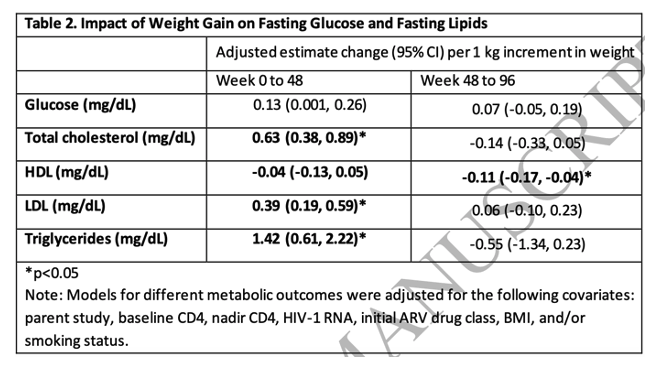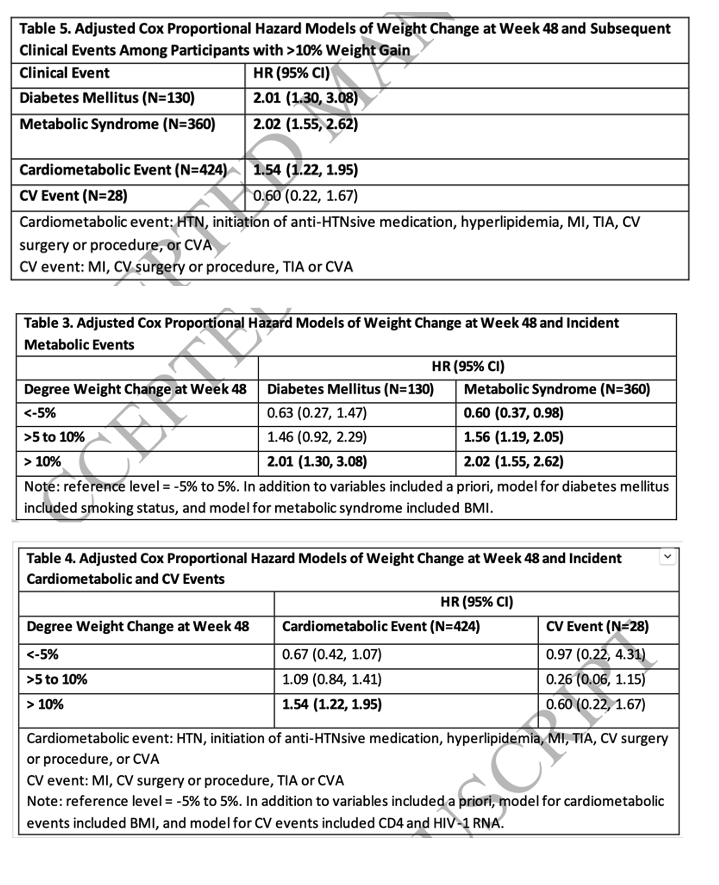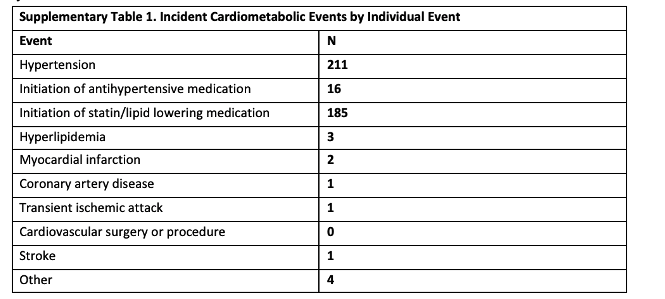| |
Diabetes, Lipids, Heart Disease: Weight gain after antiretroviral therapy initiation and subsequent risk of metabolic and cardiovascular disease
|
| |
| |
Download the PDF
sept 12 2023
There were sex & racial differences in outcomes.
Weight gain following initiation of antiretroviral therapy (ART) is common. We assessed the impact of changes in weight in the year following ART initiation with subsequent cardiometabolic disease among AIDS Clinical Trials Group (ACTG) participants.
Randomized Trials)[10] began enrolling participants previously enrolled into ACTG randomized trials. A5001 followed participants every 4 months through 2013.
In summary, ours is the first analysis of long-term cardiometabolic complications following short-term weight changes that occur after ART initiation that also includes analysis to evaluate the impact of sex and race/ethnicity on these outcomes. These data confirm the negative impact of short-term weight gain as evidenced by significant increases in the risks of incident DM, metabolic syndrome, and CV events as well as the positive impact of short-term weight loss on incident metabolic syndrome. The data also highlight important sex differences in the impact of weight gain on incident DM which illustrates the importance of investigating mechanisms other than weight gain when studying the excess risk of DM in women with HIV. Additional research is needed to determine whether weight control interventions at the time of ART initiation may help to minimize the risk of subsequent cardiometabolic disease.
Outcomes Measures
Metabolic parameters: Fasting high density lipoprotein [HDL], low density lipoprotein [LDL], total cholesterol, triglycerides and glucose were measured 2-3 times per year during A5001 and annually during A5322.
Clinical events: Two separate CV outcomes were considered: cardiometabolic events and CV events. Cardiometabolic events included hypertension, initiation of antihypertensive medication, hyperlipidemia, initiation of statin or other lipid lowering medication, coronary artery disease, myocardial infarction, stroke, transient ischemic attack, CV surgery or procedure.
CV events included myocardial infarction, CV surgery or procedure, transient ischemic attack, or stroke. Diabetes mellitus [DM] was defined as diagnosis of DM or initiation of anti-glycemic medications. Metabolic syndrome was defined as 3 or more of: WC >102cm for men or >88cm for women; blood pressure >130/85, diagnosis of or drug treatment for hypertension; fasting triglyceride level ≥150 mg/dL; fasting HDL <40 mg/dL (men) or <50 mg/dL (women); fasting blood glucose ≥100 mg/dL or incident DM.
Participants (n = 2624) were primarily male (81%) and non-White (60%). Mean weight gain from 0-48 weeks was 3.6 kg (SD 7.3); 130 participants developed DM; 360 metabolic syndrome; 424 any cardiometabolic event; 28 any cardiovascular event, over 480 weeks of follow-up.
Longitudinal changes in weight
Overall, mean (SD) weight gain from ART initiation to week 480 was 7.1 kg (10.7) and higher among female participants than male participants (7.3 kg vs 6.4 kg). The mean (SD) weight gain at week 48 was 3.6 kg (7.3) and higher among females than males (4.2 kg vs 3.5 kg). At week 48, 22% (n=550) of participants gained >10% of their baseline weight (21% of male participants, 28% of female participants).
At week 480, 40% (n=118) of participants gained >10% of their baseline weight (38% of male participants, 45% of female participants).
Interestingly, this is in line with weight trends in the general US population as noted in a recent cross-sectional study where 36% of adults in the US gained 10% or more of their baseline body weight over ten years [11].https://www.ncbi.nlm.nih.gov/pmc/articles/PMC9106499/
In adjusted models, total cholesterol increased by 0.63 mg/dL (95% CI 0.38, 089) and LDL by 0.39 mg/dL (0.19, 0.59) per 1 kg increase in weight from weeks 0-48.
Participants who experienced >10% weight gain (vs -5% to 5%) had an increased risk of DM (HR 2.01, 95% CI [1.30, 3.08]), metabolic syndrome (HR 2.24 [1.55, 2.62]), and cardiometabolic outcomes (HR 1.54, 95% CI [1.22, 1.95]). Participants who lost more than 5% of their baseline weight had a lower risk of incident metabolic syndrome (HR 0.67 [0.42, 1,07]). Trends for WC were similar.
Association between baseline CD4 cell count and weight gain
Baseline CD4 of <200 cells/uL was significantly associated with both weight gain >10% and treatment emergent obesity (HR 5.02, 95% CI [4.23-5.95], p<0.001 and HR 2.76 95% CI [2.25, 3.39], p<0.001, respectively).

Race & Sex Differences:
We also found associations between weight gain, race/ethnicity and incident cardiometabolic outcomes. The association between a weight increase of >5% to 10% (vs -5% to 5%) and incident metabolic syndrome was only apparent among those of White race, whereas we found a stronger association between a weight increase of >10% (vs -5 to 5%) and incident cardiometabolic events among those of Black race and those not of Hispanic/Latino ethnicity.
We found evidence of sex differences in the association between weight gain and incident DM such that male participants who experienced >10% weight gain at week 48 had a 2.5 times higher incidence of DM whereas female participants who experienced >10% weight gain did not have an increased risk of incident DM. This finding is notable when considered alongside the results of a recent cross-sectional analysis in which HIV was determined to confer an increase in the odds of DM among women but not men [23]. In this study, Birabhaharan and colleagues found the prevalence of obesity was higher in women with HIV than in men with HIV, but that women were more likely to have DM after controlling for obesity. It is possible that mechanisms other than weight gain (e.g., enhanced inflammation and immune activation) may be implicated in the excess risk of DM among women with HIV.

Association between weight gain and change in fasting metabolic markers
In multivariable models adjusting for baseline BMI, history of DM, and history of hypertension,
for every 1kg increase in weight from weeks 0 to 48, fasting glucose increased by 0.13 mg/dL
(95% CI [0.001, 0.26], p=0.05). The increase from weeks 48-96 was less pronounced and no
longer clinically significant (0.07 mg/dL, 95% CI [-0.05, 0.19], p=0.23) (see Table 2).
In multivariable models adjusting for parent study, baseline CD4, nadir CD4, HIV-1 RNA, initial
ART drug class, baseline BMI and smoking status, for every 1kg increase in weight from weeks
0 to 48, total cholesterol increased by 0.63 mg/dL (95% CI [0.38, 0.89], p=0.05), LDL by 0.39
mg/dL (95% CI [0.19, 0.59], p<0.001), triglycerides by 1.42 mg/dL (95% CI [0.61, 2.22],
p<0.001), while HDL decreased by 0.04 mg/dL (95%CI [-0.13, 0.05], p=0.39). The associations
between weight gain from week 0 to 48 and changes in fasting lipids at week 48 to 96 were less
pronounced and non-significant except for HDL, which decreased by 0.11 mg/dL (95% CI [-
0.17, -0.04], p=0.002) for every 1 kg increase in weight (see Table 2).
There was no evidence of effect modification by sex, race or ethnicity in the associations
between weight gain and change in fasting metabolic markers.
Association Between weight change at week 48 and incident diabetes
One hundred three individuals with prevalent DM and 13 with DM that occurred within the first
48 weeks after ART initiation were excluded. Among those without DM prior to week 48, 130
participants developed DM after week 48. After adjusting for age, sex, race/ethnicity, baseline
BMI, history of dyslipidemia and smoking status, those who experienced >10% weight gain by
week 48 had a significantly higher risk of incident DM than those who experienced a weight
change between -5% and 5% (HR 2.01, 95% CI [1.30, 3.08], Table 3).
DOI: 10.1093/cid/ciad545 6
Male participants who gained >10% weight at week 48 had a 2.5 times higher incidence of DM
(HR 2.48, 95% CI [1.55, 3.98]) than those with a weight change between -5% and 5%; this
increased risk was not seen among female participants (HR 0.91, 95% CI [0.34, 2.45]);
interaction p=0.07.
There was no evidence of effect modification by either race or ethnicity in the association
between weight gain and incident DM.
Association between weight change at week 48 and incident CV events
Thirty-two individuals with prevalent CV events and one with a CV event that occurred within
the first 48 weeks after ART initiation were excluded. Twenty-eight incident CV events occurred
after week 48. After adjusting for age, history of DM, hypertension or dyslipidemia at baseline,
family history of cardiovascular disease, smoking status, baseline CD4 count and HIV-1 RNA,
weight change was not associated with incident CV events.
Association between waist circumference change at week 48 and metabolic and clinical
outcomes
Similar associations were observed for an increase in waist circumference of >7cm versus ≤3cm
and all metabolic and clinical outcomes (data not shown).
Association between weight change at week 48 and incident metabolic syndrome
Seven hundred seven individuals with prevalent metabolic syndrome and 375 who developed
metabolic syndrome within the first 48 weeks after ART initiation were excluded. Among those
without metabolic syndrome prior to week 48, 360 participants developed metabolic syndrome
after week 48. Those who lost more than 5% of their baseline weight had a lower risk of
developing metabolic syndrome (HR 0.60, 95% CI [0.37, 0.98]) whereas those who experienced
>5-10% weight gain and >10% weight gain had a 50% and two-fold higher risk of developing
metabolic syndrome (HR 1.56, 95%CI [1.19, 2.05] and HR 2.02, 95% CI [1.55, 2.62],
respectively) than those who experienced a weight change between -5% and 5% (Table 3).
By race, the association between a weight increase of >5-10% (vs -5 to 5%) and incident
metabolic syndrome was apparent only among those of White race (HR 2.18, 95% CI [1.51,
3.16]) but not Black race (HR 1.08, 95% [CI 0.61, 1.95]) or other race (HR 1.14, 95% CI [0.64,
2.03]); interaction p=0.06 for contrast between White vs other race). There was no evidence of
effect modification by sex or ethnicity in the association between weight gain and metabolic
syndrome.

Association between weight change at week 48 and incident cardiometabolic events
Cardiometabolic events included hypertension, initiation of antihypertensive medication,
initiation of statin or other lipid lowering medication, hyperlipidemia, myocardial infarction,
transient ischemic attack, CV surgery or procedure, or stroke (Supplementary Table 1). Six
hundred ninety-nine individuals with cardiometabolic events that occurred before ART initiation
and 235 with cardiometabolic events that occurred within the first 48 weeks after ART initiation
were excluded. 424 participants had a cardiometabolic event after week 48. After adjusting for
age, history of DM, family history of CV disease, smoking status and BMI, we found that those
who experienced >10% weight gain had a significantly higher risk of experiencing a
cardiometabolic event (HR 1.54, 95% CI 1.22, 1.95) as compared to those with a weight change
of -5% to 5% (Table 4). There was no significant association for those who lost more than 5% or
those who gained between 5 and 10% of their baseline weight.
By race, the increased risk of incident cardiometabolic events was seen among White and Black
participants who gained >10% weight (vs -5% to 5% weight change) at week 48, but not among
participants of other races (HR 1.71 95% CI [1.20, 2.44] for White participants, interaction
p=0.15 (White vs. other race); HR 2.02 95% CI [1.32, 3.12] for Black participants, interaction
p=0.07 (Black vs. other race); HR 1.13 95% [CI 0.72, 1.78] for other participants). When
evaluated by ethnicity, only non-Hispanic participants who gained >10% weight at week 48 (vs -
5% to 5% weight change) had a higher risk of incident cardiometabolic events (HR 1.85 95% CI
[1.41, 2.42]; interaction p=0.05).
|
|
| |
| |
|
|
|